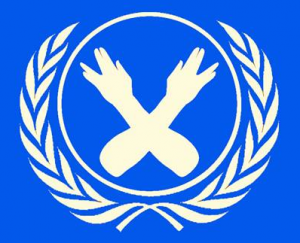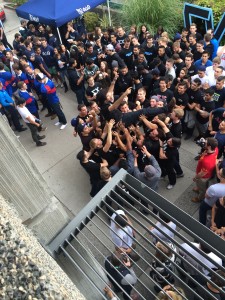In this second blog post of mine, I am going to write about a club event that I attended. The club is called the UBC Nerdfighters Club and the event was their Dead Poets’ Society Halloween Event.
So, Nerdfighter? What’s that? The UBC Nerdfighter Club describes their purpose on their Facebook page:
Our goal is to bring together the local Nerdfighteria community to decrease worldsuck and have some fun while we’re at it.
DFTBA
Still confused? Let me unpack that for you. By the end of this blog post, I hope to give you a sense of what I’ve discovered the UBC Nerdfighters Club to be about and how club members use the club to negotiate their identity. I am going to unpack what it means to be a “Nerdfighter” in “Nerdfighteria” and, to do so, I am going to employ the theoretical help of Goffman’s (1961/2012) piece, Asylums, as well as Foucault’s (1975) piece, Discipline and Punish.
I did not have much of an idea of what a Nerdfighter was until I went to this club event. A close friend of mine had told me about the club before and had tried to explain what it was, what members did, and why they did it, but the terminology that she used to describe the Nerdfighter culture (i.e. “worldsuck”) threw me off a bit. I asked her to take me to a club event so I could see for myself what the club and its members were about… this led to us attending a Halloween event they named the Dead Poets’ Society (after the movie, I assume… although I have not seen the movie myself if I am being honest). The gist of the event was that, in gearing up for Halloween, we were all to meet up, eat a lot of sugar, and have a poetry circle of sorts where everyone brought some “spooky” material to read to the group.
When we walked into the room that the event was being held in, we were met by many rounds of “Hello!” from other club-goers. We all sat in a circle of chairs and helped ourselves to baked goods. We began the night with introductions. Going around the circle, each person was to introduce themselves by name along with a declaration of which Hogwarts House they were in (Pottermore-dictated or otherwise). Next, as per promised, everyone took turns sharing poetry. I heard everything recited from Edgar Allen Poe to J.R.R. Tolkien (recited poetry from a club member as well as an audio recorded version of Mr. Tolkien himself narrating it—both in elvish) to the “Monster Mash” (because, as club members voiced, no Halloween celebration would be complete without it). As the poetry began to taper off, the topic of viral Youtube videos came up and so our group watched some popular and comedic Youtube videos that, seemingly to me anyway, appeared irrelevant to poetry but nonetheless enjoyable. This soon led to a big group discussion on television shows as well as past/upcoming movies based on comic books, which led to a group debate on DC versus Marvel comic book characters.
At this point in the night, I was starting to get a good feel for the atmosphere in the club—it seemed that nothing was totally off-topic for them and everyone got caught up in the different fandom subjects with ample amounts of liveliness. It was at this point that I explained to everyone that I was new to learning what “Nerdfighteria” was all about and gave an open question out to the group to enlighten me and describe what the club meant to them. I explained that, to me, it seemed that if club members were interested in topics of sci-fi and fantasy literature and film (as were continuously brought into discussion), they could just as easily join the UBC Sci-Fi and Fantasy Club. I was confused as to how the UBC Nerdfighters Club was any different from this.
In answer to my questions, club members then pointed out to me that, actually, two executives of the UBC Sci-Fi and Fantasy Club were at the event too and that Nerdfighters had a distinctly different culture than just being interested in sci-fi and fantasy fandoms. A club executive explained that “Nerdfighteria” is a community (primarily an online community) stemming from the VlogBrothers, John and Hank Green. Basically, John and Hank Green are two brothers who post video blogs on Youtube. Their vlogs have gained popularity and have happened to intersect with many sci-fi and fantasy fandoms because of some of the content in the vlogs include John and Hank Green’s musings about their various fandom interests, however one club member explained to me that it was not just about the fandoms per se: “The cool kid in middle school that you never were—here, you’re cool.” Another club member added that the club was a place where anyone could come to be an enthusiast at, no matter what you wanted to be enthusiastic about. It was also explained to me that the club was about “doing good” by “decreasing ‘worldsuck’—things that make the world sucky” and “increasing ‘worldawesome’—things that make the world awesome.” I was told that increasing worldawesome is done in a couple ways. One of the most essential ways to increase worldawesome is by facilitating acceptance (acceptance of different likes and interests, acceptance of different ways of thinking, acceptance of different people). Another way to increase worldawesome is done through the number of projects that the Vlogbrothers have founded to promote charity and awareness to different causes—most notably, the Project for Awesome.
To give some theoretical backdrop for how I understand Nerdfighters to be constructing their identity, I will first introduce Goffman (1961/2012). Goffman (1961/2012) begins by writing on the characteristics of ‘total institutions’. He defines total institutions as structures of “residence and work where a large number of like-situated individuals [are placed], cut off from the wider society for an appreciable period of time, together lead an enclosed, formally administered round of life” (492). Goffman (1961/2012) points to mental hospitals and prisons as examples of total institutions. He writes that total institutions facilitate a “mortification of self”: “process of ‘killing off’ the multiple selves possessed prior to one’s entrance into the total institution and replacing them with one totalizing identity over which the person exercises little control” (492). Goffman (1961/2012) notes that, in these total institution settings, individuals who go against the administrative totalizing force often have their behaviour characterized as “acting out”—he emphasizes that this “acting out” is really just a way these individuals are attempting to preserve their self-autonomy and preserve their behaviours as of their own doing.
While he writes on how mental hospitals and prisons as total institutions shape the self through isolation, regulation, and formal administration tactics, these examples also shed light on the nature of the self as it is experienced in more “ordinary” civilian settings. He understands that an individual’s identity is something that is constantly being defined by the restrictions and freedoms that other institutions place onto the individual (Goffman, 1961/2012). He writes that “the individual… [is] a stance-taking entity, a something that takes up a position somewhere between identification with an organization and opposition to it, and is ready at the slightest pressure to regain its balance by shifting its involvement in either direction. It is thus against something that the individual can emerge” (Goffman, 1961/2012, p. 502). Goffman (1961/2012) specifies that “Our sense of being a person can come from being drawn into a wider social unit; our sense of selfhood can arise through the little ways in which we resist the pull. Our status is backed by the solid buildings of the world, while our sense of personal identity often resides in the cracks” (502).
Quick to emphasize themes of opposition, Goffman (1961/2012) would help explain how the Nerdfighters find their identity in resisting the pull against the rigid boxes that society puts around what it means to “be cool” and what are the acceptable ways for an individual to “be”—behaviour, likes/interests, and otherwise. The idea of Nerdfighteria is a notion to extend acceptance to all individuals no matter where they come from, what they like, or how they think to oppose this totalizing idea that being cool is not to indulge in things that may be considered by larger society as being “nerdy”.
Foucault (1975) piece can also aid us in understanding this relation of power in Nerdfighteria as an aim to redefine what being nerdy entails. In Discipline and Punish, Foucault (1975) writes that power is a relation between the “powerful” and the “powered”. He writes that the relation between the two characterizes the following causal relations: if the powered disobey the powerful, the powerful punishment powered, and so the powered remain submissive to avoid this punishment. This internalization of discipline Foucault borrows from Bentham’s conception of the Panopticon.
Being a nerd is often denoted as an undesirable (sucky) status. Nerdfighter culture is a movement to reclaim the status and re-define what it means to be a nerd and re-define it as something that is awesome. In Nerdfighteria terms, Nerdfighters (previously, the powered) aim to reclaim the power by redefining what is “sucky” and what is “awesome” (“awesome” wields the power, “sucky” denotes non-power). Nerdfighteria attempts to break a setting that functions as both Panopticon and total institution.
John Green gives a simple definition of what it is to be Nerdfighter: “a Nerdfighter is a person who, instead of being made out of bones and skin and tissue, is made entirely of awesome.” I conclude on the note that, rather than fighting against nerds (as the name might suggest), the term embodies fighting FOR nerds and being “pro-nerd” by pushing against the bounds of worldsuck and redefining worldawesome as a push against totalizing social pressures and against these pressures that attempt to instill an internalized discipline.
…Lastly, what of the mysterious acronym “DFTBA”? It is the motto of Nerdfighteria meaning “Don’t Forget To Be Awesome.”

References
Foucault, M. (1975). Discipline and Punish. New York: Pantheon, 622-636.
Goffman, E. (2012). Asylums: Essays on the Social Situation of Mental Patients and Other Inmates. In S. Appelrouth & L. Desfor Edles (Eds.), Classical and Contemporary Sociological Theory (2nd ed., pp. 492-502). Thousand Oaks, California, USA: Pine Forge Press. (Original work published in 1961)



